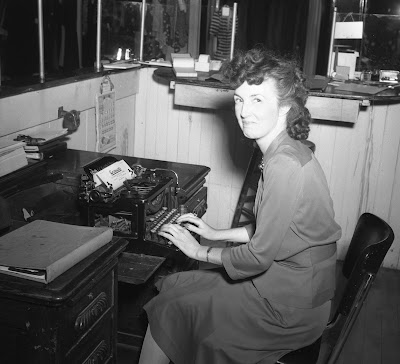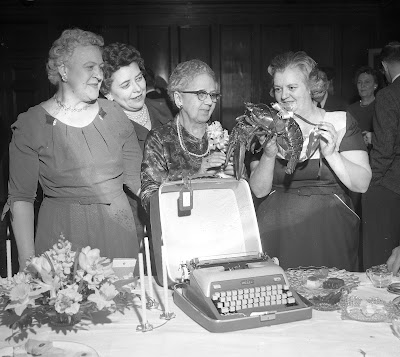"The human mind, itself invisible,
becomes visible or manifest in words,
and writing, and gestures."
~ Frederick Copleston, A History of Philosophy, v.2.
The lengthened light of spring establishes itself once again. Fresh seasons turn the wheels of writers, return carriages recharged, prime platens, and calibrate keys anew, as we seek greater escapements into rejuvenating journeys. Economics, politics, and popular culture are no better than they were last month, yet somehow hope springs eternal. Defeat is mysteriously negated beneath fresh green baseball lawns. Flagging energies rekindle in such ocean winds as those which flog the Maine coast today. Renewed expectations become less our testaments of struggle, and rather causes for our optimism. And for the cause of encouragement, here are some images which have not seen light of day in a very long time- some not ever- to inspire you to shine up your writing instruments and train your springs through your own spring training. Archival documentation reminds us of souls who’ve gone before us.
Recently, I completed a thorough archival survey of approximately seventy years of newspaper photographic negatives. Woven around and through my daily work duties, and using every bank holiday, it took slightly over three years for me to review an estimated 1.2 million negatives. It was a rescue effort, as the huge collection was nearly discarded in a building-emptying corporate downsize. The project for me has been an adventure filled with wonder and fascination. Amidst dust, rust, and acrid acetic acid odors, I’ve witnessed my home region’s twentieth century in silver cellulose. Crates and rotted cabinets filled with disorganized film is now under control and being indexed for conservation and future studies. Out of chaos comes order. This experience of perseverance and accomplishment will always accompany my thoughts, and I’ve gratefully combined my photographic roots with my archivist’s sense. Readers of these pages may remember graphite archive, which incorporated pencil-writing images I discovered as I made my way through the collection. The decades illustrated in these negatives also comprised numerous images of typewriters, and indeed I indexed these, too. The same eyes that could recognize a pencil in a subject’s hands in the reverse image of a photo negative could also identify the presence of a typewriter. Still photographs potentially offer immense amounts of information about their respective context.
As many of us already know, typewriters are extraordinary motifs for photography. The machines themselves are far from being impersonal mechanical contraptions. Typewriter owners have always tended to make the machines their own, thus extending personal touches through instruments sensitive to the human touch. Even typestyles and sizes vary among the varieties of machines and their epochs. When you observe this selection of photographs, notice how people and their typewriters are pictured together. Authors and their machines appear parallel to concert pianists and their particular expressive instruments. Every student and professional needed a typewriter; these tools were especially required in order to compose correspondence, submit polished reports, scripts, and to finalize projects. Notice the vitality of typewriters in offices, personal studies, schools, and on chemists’ countertops. Typewriters continue to be instruments for creative writers. From the machines themselves, notice the sampling of environments- in this case, it is northern New England from the late 1930s through the early 1980s. Look at the typewriters’ habitats, along with those of the writers themselves (this essay can also be viewed as a slide show).
Having so many indexed images to present, I chose to categorize them in this essay by the uses of typewriters by students, professionals, creative writers and authors, and in places of procurement. The latter category refers to the need for supply sources for typists’ commodities and places for repair. Consider the parallels with automobile showrooms and garages, and contemporary bicycle shops. Here’s to the Typosphere, those who straddle the ether of the internet with the solidity of their cherished Olympias, Underwoods, Olivettis, Smith-Coronas, Royals, Adlers, and on and on, persevering with the passion (and shoulders) required to produce bold marks on a manual platen. Cheers to the ‘spheres!
at school
at work
creativity
sources










































11 comments:
I love these photos. Thanks!
Thank you very much for your work in preserving and cataloging these photos, and sharing these with us! I'm always amazed at the depth and detail in your essays, so it shouldn't surprise me that you'd do a great "lookit these typewriter-related photos I found" post as well.
Excellent! :D
Nice collection of photos. Love the Olivetti Lettera DL/Lettera 33.
These photos are fabulous -- can you reproduce them into a book or zine? please? I must have them. Being a photographer myself (both fine art photography and newspaper photography) I am rather jealous of that opportunity you had to sort through those negatives. But I also know what a tedious job it was. And--guess what--for my recent birthday my sweetie gave me that Smith-Corena with the extra large carriage featured in one of your photos. With script type. I have been typing like crazy.....
Amazing! Thanks for posting this archive.
I was struck by the irony of the "You've come a long way, baby." display.
The two women typing over tea is an interesting image. Were they plotting to overthrow the government? One nice thing about unlabeled photos is that the viewer can create their own back story.
What treasure!
Just beautiful!
Waiting for the "Radiosphere"
Thanks DJS !
Here's a radio essay you might also enjoy:
http://laviegraphite.blogspot.com/2009/11/airwaves.html
great photos, and so diverse. The typewriter will always be the primary symbol of writing for me. Thanks for posting. rino
Thanks to Pamela for sending us your way to see these fabulous photos. I love old photographs and these even brought the smell of the ribbon and the office supply stores to mind. Thanks for sharing!
Wow, these are great; thanks for telling me about this collection. I especially like the photos of the stores. I don't think I ever went into a "typewriter store" back in the 70s-80s -- I'm pretty sure the electric typewriters we had at home came from Sears (my family got everything from Sears back then).
Post a Comment